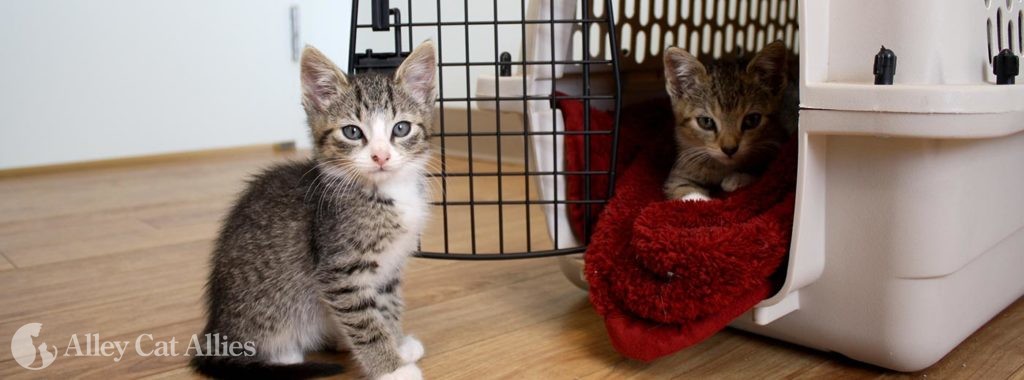May 8 is National Animal Disaster Preparedness Day. Today, if you have not already, Alley Cat Allies recommends taking time to create a disaster plan for your cats and other indoor animals. Additionally, the right plan can help ensure the safety of community cats you care for outdoors.
Since 1990, Alley Cat Allies has responded to disasters from hurricanes to floods, tornadoes, earthquakes and wildfires—including the tornadoes in Mississippi and Arkansas this season. Through our work on the ground, we’ve learned that the key to saving lives is PREPARATION. Having a plan for ourselves and our families is crucial in the event of an unexpected emergency.
These are our top Disaster Preparation guidelines to protect your family, including its furry members.
For Indoor Cats and Other Pets:
Prepare to evacuate ALWAYS with your pets
Even if your house is spared, it could be a long time before you are authorized to return. Your pets could be trapped for a prolonged period without care if they are left behind.
Identify where you can evacuate
Plan out as best you can ahead of time by consulting with friends and family who are out of your immediate area. Identifying a pet-friendly hotel or boarding facility outside the area is also recommended. Research where your community sets up evacuation shelters, keeping in mind that some shelters do not accept animals.
Plan in case you are not home during a disaster
You can place stickers on the doors to your home to notify rescue personnel that animals are present, and where they can find your evacuation kit. If possible, recruit a willing neighbor you trust to evacuate with your pets in case you are gone.
Microchip your cats
A microchip registered with your up-to-date information greatly increases the likelihood that you and your cat are reunited if you become separated. Additionally, to easier identify your cats, keep photos of them on your cell phone or elsewhere on your person.
Create a Disaster Kit
This kit should always remain in an easy-to-access spot so you can grab it during evacuation. Remember to periodically refresh the items within to ensure nothing is expired or broken. The kit should include:
- Pet food and bottles of water (at least a five-day supply)
- Medications
- Cat litter/pan
- Food/water dishes
- Blankets and toys
- Paper towels and plastic bags for clean-up
- Collars and tags for each pet, leashes for dogs, harnesses for cats
- Cage/carrier, one for each animal, labeled with your contact information
- Vaccination/veterinary records, photos, and descriptions of each of your pets in a waterproof zip-lock bag
Learn more with our Including Pets in Your Family’s Disaster Plan guide.
For Community Cats:
Do not bring community cats indoors or evacuate with them
Evacuating with community cats, who are generally not socialized, is not recommended or realistic. Community cats have thousands of years of ingrained instincts that help them to survive in their outdoor homes, even during the worst circumstances. Plan around those instincts and know that cats can hide for several days after a natural disaster.
Make sure every cat is spayed or neutered through TNR
TNR, or Trap-Neuter-Return, is the process through which community cats are humanely trapped, spayed or neutered, vaccinated, eartipped, and returned to their outdoor homes. As a result, you won’t have to worry that community cats have kittens with any cats displaced by the disaster.
Keep identification of every cat in your colony
The documentation should include each cat’s appearance, their spay and neuter status, and more. As best you can, take photos of each cat. Equally important, ensure each cat is MICROCHIPPED with your information as their caregiver registered and up to date. All of this will not only help you keep track of each cat after the disaster but also help identify community cats if they are trapped by rescuers or impounded in shelters.
Enlist a backup caregiver
This caregiver will be responsible for the community cats in your absence. You can even build a network with other caregivers in your area to create a safety net of care for the cats. You can also contact TNR and community cat organizations in the area and discuss disaster preparation.
Make a list of local shelters
You will need this information in case you need their help, or need to determine if a community cat was impounded during the disaster.
Prep the cats’ outdoor home
For example, if you live in a flood or hurricane-prone area, put cat shelters and feeding stations on higher ground or move them there if a disaster is predicted. Make sure cats have more than one escape route from where they typically hide or rest, keeping in mind that many community cats prefer to sleep under sheds, houses, and decks. Fill multiple food and water bowls in case you have to evacuate and can’t immediately return.
See our Disaster Proofing a Community Cat Colony resource to learn more.
For more guidance to protect the cats you care for in the event of an emergency, read our Disaster Preparation Tips.


